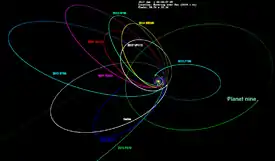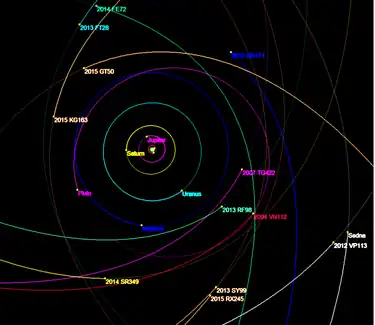2014 FE72
2014 FE72 is a trans-Neptunian object first observed on 26 March 2014, at Cerro Tololo Inter-American Observatory in La Serena, Chile. It is a possible dwarf planet,[5] a member of the scattered disc, whose orbit extends into the inner Oort cloud.[1] Discovered by Scott Sheppard and Chad Trujillo, the object's existence was revealed on 29 August 2016.[1][8] Both the orbital period and aphelion distance of this object are well constrained.[2] 2014 FE72 had the largest barycentric aphelion until 2018. However, the heliocentric aphelion of 2014 FE72 is second among trans-Neptunian objects (after the damocloid 2017 MB7).
 Diagram showing the highly eccentric orbit of 2014 FE72 | |
| Discovery[1] | |
|---|---|
| Discovered by | |
| Discovery site | Cerro Tololo Obs. |
| Discovery date | 26 March 2014 |
| Designations | |
| 2014 FE72 | |
| Orbital characteristics[2] | |
| Epoch 21 January 2022 (JD 2459600.5) | |
| Uncertainty parameter 3 | |
| Observation arc | 6.98 yr (2,549 days) |
| Aphelion |
|
| Perihelion | |
| |
| Eccentricity |
|
| |
| 0° 0m 0.055s / day | |
| Inclination |
|
| |
| ≈ 6 October 1965[4] ±11 days | |
| |
| Physical characteristics | |
Mean diameter | 270 km (est. at 0.08)[5][6] |
| 24.3[7] | |
| 6.19[2] | |
Orbit
 Orbits of 2014 FE72 (green, at lower left) and other scattered/detached objects, along with hypothetical Planet Nine on the right
Orbits of 2014 FE72 (green, at lower left) and other scattered/detached objects, along with hypothetical Planet Nine on the right 2014 FE72 is seen at the top here in green, moving away from the Sun
2014 FE72 is seen at the top here in green, moving away from the Sun
Using the Solar System Barycenter as the orbital frame of reference, 2014 FE72's extremely elongated orbit (eccentricity = 0.98) has a perihelion of 36.1 AU, an aphelion of ~4,050 AU and a barycentric orbital period of ~92,400 years.[3] The latter values are the largest known for any Solar System body that is not a long-period comet.[n 1] Based on the barycentric orbital period, 2014 FE72 takes roughly 5 times longer than Sedna to orbit the Sun.[10]
2014 FE72 last passed through perihelion around late 1965.[2]
See also
Notes
- 2017 MB7, an apparently much smaller object (absolute magnitude ~14) which might be an extinct comet, has a similar barycentric aphelion of ~2,800 AU and an orbital period of ~54,000 years.[9]
References
- Williams, G. V. (29 August 2016). "MPEC 2016-Q43 : 2014 FE72". Minor Planet Center. Retrieved 31 August 2016.
- "JPL Small-Body Database Browser: (2014 FE72)" (2021-03-18 last obs). Jet Propulsion Lab. Archived from the original on 5 February 2018. Retrieved 26 August 2018.
- Horizons. "JPL Horizons: Barycentric Osculating Orbital Elements for 2014 FE72". Retrieved 6 June 2022.
- JPL Horizons Observer Location: @sun (Perihelion occurs when deldot changes from negative to positive. Uncertainty in time of perihelion is 3-sigma.)
- Michael E. Brown. "How many dwarf planets are there in the outer solar system? (updates daily)". California Institute of Technology. Retrieved 15 September 2016.
- "Absolute magnitude (H)". Near Earth Object Program. NASA/Jet Propulsion Lab. Archived from the original on 2 March 2001. Retrieved 15 September 2016.
- "AstDyS 2014FE72 Ephemerides". Department of Mathematics, University of Pisa, Italy. Retrieved 12 November 2018. (Distance to Sun [R] from 2016 to 2020.)
- "Hunt for ninth planet reveals new extremely distant Solar System objects". CarnegieScience.edu. Carnegie Institution. 29 August 2016. Retrieved 31 August 2016.
- JPL Small-Body Database Browser: (2017 MB7)
- Horizons. "JPL Horizons: Barycentric Osculating Orbital Elements for (90377) Sedna". Retrieved 12 November 2018.
External links
- 2014 FE72 at AstDyS-2, Asteroids—Dynamic Site
- 2014 FE72 at the JPL Small-Body Database